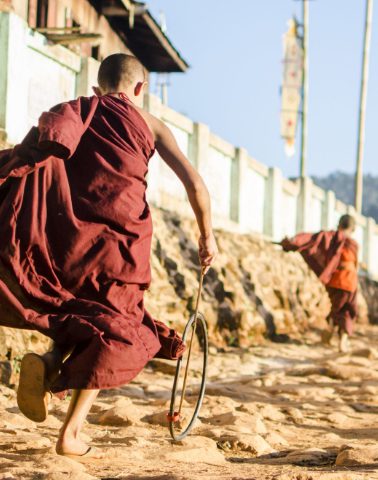
Subscribe to our mailing list
We are still here! Let us send you tips for travelling through Myanmar and stories from the road …
This is a literary journey through India for anyone, but particularly suited for those who love to read and those who want to write. More on Abir here.
This journey includes a 7-night private cruise on the Brahmaputra River in Assam. Excursions will be made to Kaziranga National Park, the Jorhat tea gardens, and Majuli – the world’s largest river island. Over the course of three mornings, Abir will lead literary masterclasses. On one evening aboard the ABN Sukapha, he will introduce the concept of the “closed circle mystery” before a screening of Agatha Christie’s Death on the Nile.
This journey begins in Kolkata: first city of the British Raj and birthplace of Indian nationalism. It’s in 1920s Kolkata that Abir sets his “Wyndham & Banerjee” detective series:
“It’s a fascinating city, unique in many respects and in the 1920s, it was the premier city in Asia, as glamorous and exotic a location as anywhere in the world. The history of Calcutta is the history of the British in India. Their presence still cries out from its streets, its buildings and in its outlook.”
Cruising along the river, between lazy lunches and leisurely excursions, we will enjoy good food in great company, with time to think, time to dream, time to read and time to write …
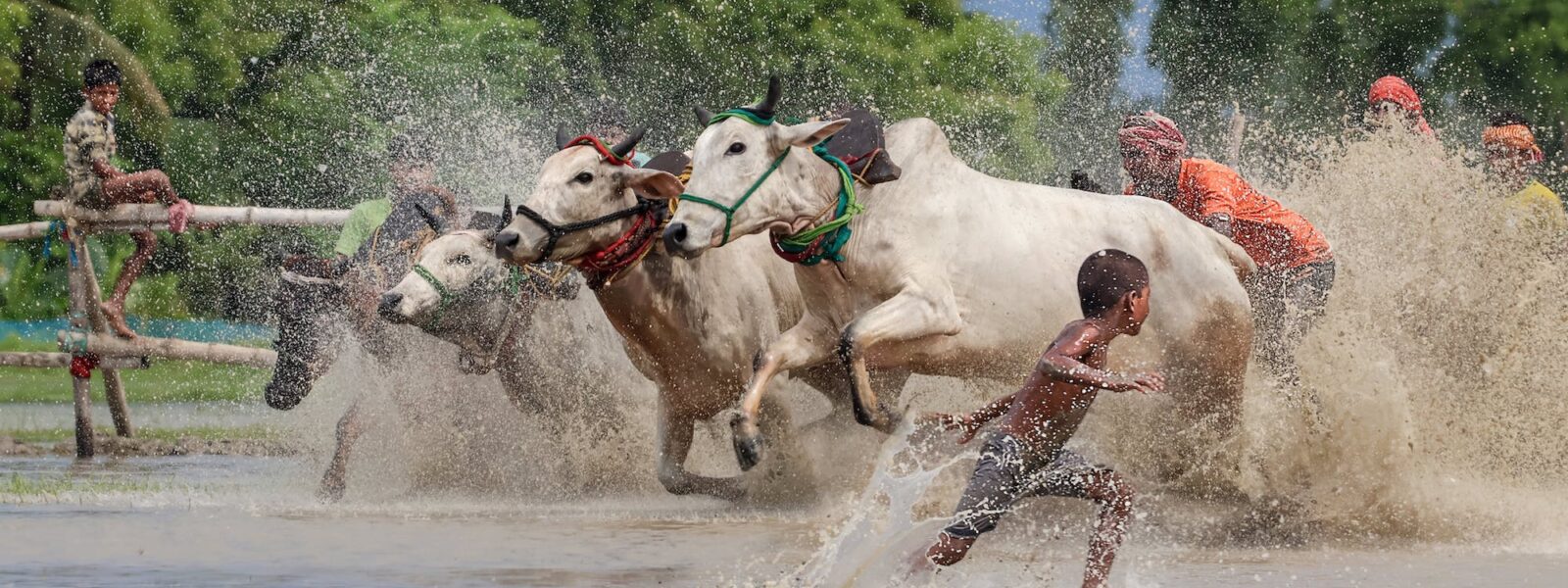
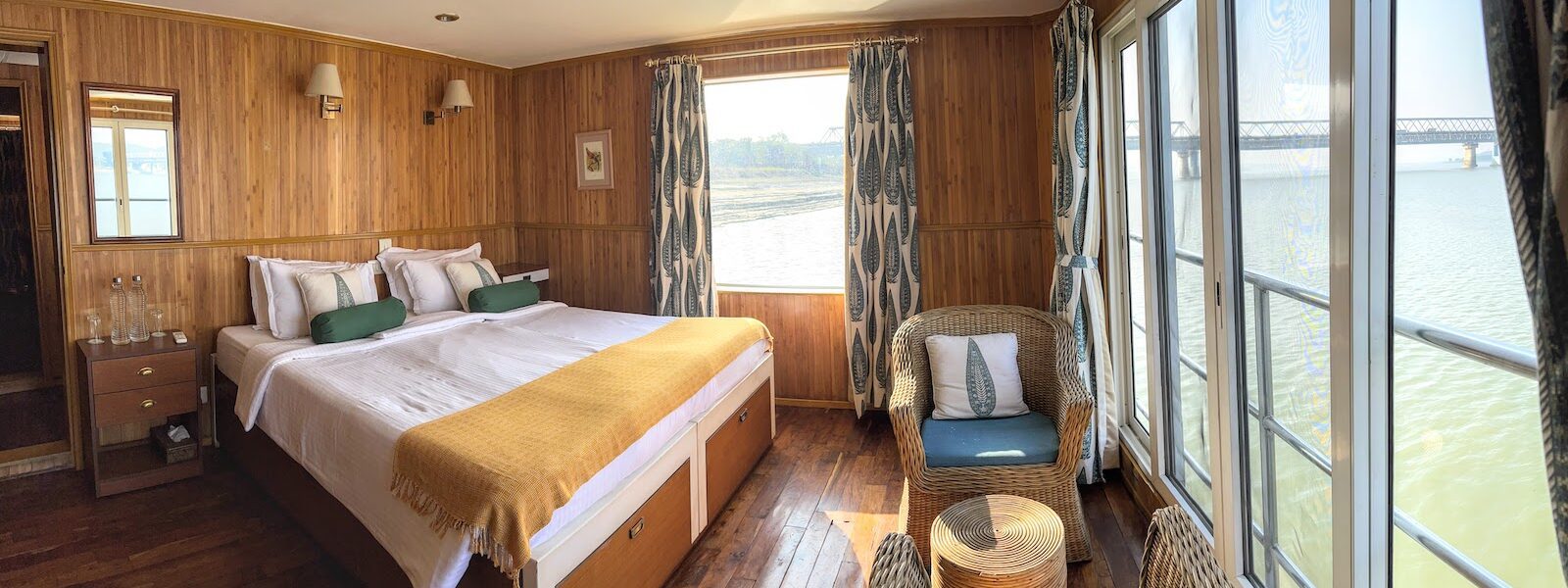
ABN Sukapaha is the finest vessel cruising on the Brahmaputra. In a bid to preserve India’s rich forests, the 12 upper deck cabins of the ABN Sukapha feature bamboo panelling, air conditioning and spacious en suite bathrooms. These cabins boast expansive, sliding windows that offer breathtaking panoramic vistas of the river. Onboard amenities include a spa and a saloon furnished with a library. The dining area is situated on the main deck, while an expansive sundeck graces the uppermost level. Throughout the vessel, guests will find cane furniture, objet d’arts and handlooms, all meticulously crafted by talented artisans from Assam, showcasing the region’s rich artistic heritage.
The ABN Sukapha was meticulously crafted to traverse the currents of the Brahmaputra River. The Brahmaputra, one of Asia’s major waterways, flows majestically across Tibet, India and Bangladesh. Originating from the Tibetan Himalayas as the Yarlung Tsangpo, it surges through diverse landscapes, shaping the geography and livelihoods of millions.
As it enters India, the river traverses the North Eastern state of Assam, nurturing the fertile plains of the Brahmaputra Valley. The Brahmaputra is both a lifeline and a formidable force, influencing agriculture, transportation and culture along its banks. The river’s annual floods bring fertility to the soil but also pose challenges. Its immense delta, known as the Sundarbans, is a UNESCO World Heritage Site and a crucial habitat for diverse flora and fauna, including the elusive Bengal tiger.

“I wanted to explore the effect of empire on both the rulers and the ruled.”
Abir came to writing through “a bit of a mid-life crisis”.
“I was thirty-nine, hurtling towards forty and I thought, maybe there might be more to life than accounting. I’d always wanted to write a book and it seemed safer than other methods of dealing with my stage of life, like buying a motorbike and piercing my ear.”
That was 2013 – when Abir began writing the first adventure of Captain Sam Wyndham: a British policeman in 1920s Calcutta. Abir’s Wyndham & Banerjee series has now been translated into fifteen languages. He’s twice won the CWA Dagger for best Historical Novel, as well as the Prix du Polar Européen and the Wilbur Smith Award for Adventure Writing. Abir’s parents are from Kolkata. He grew up in Scotland and now lives in Surrey with his wife and two sons.
Abir’s first book, A Rising Man, sees Captain Wyndham (widower, cynical war veteran, opium fiend) arrive in Calcutta to join the Imperial police. The backdrop is a restive India. The year is 1919 – General Dyer’s troops had just massacred a crowd of unarmed civilians in Amritsar. Sam’s side-kick is Sergeant Surendrenath Banerjee. Although not an advocate for colonialism, Suren has joined the police in the belief that his country will need trained policemen upon independence. Through his series of crime thrillers, Abir deftly threads the tension and contradictions between the relationship of these two men and the countries they represent.
This tour has been crafted for those who love to read. But it is a no-brainer for those who love to write. In the saloon and upon the sun deck of the ABN Sukapha, over the course of three mornings Abir will run three literary masterclasses. Abir will offer a 101 on crime writing; introduce the art of historical fiction; and sketch out the path to publication.
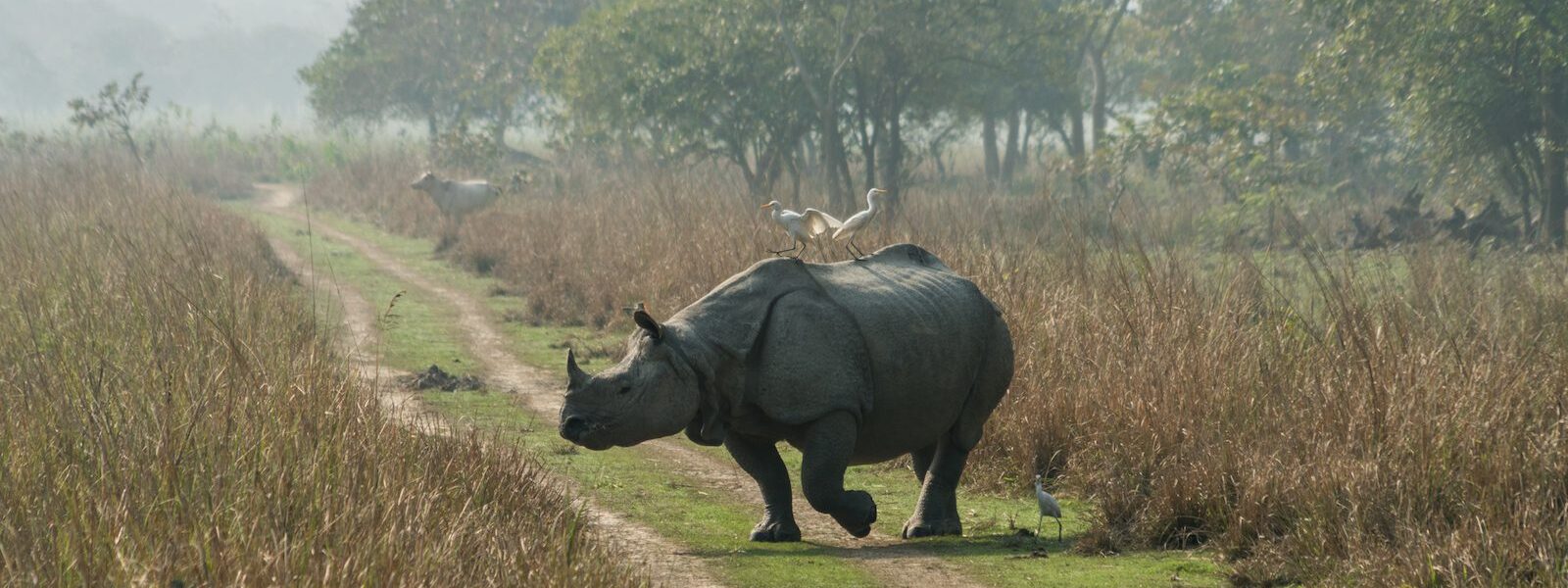
Spanning over 430 square kilometers, Kaziranga National Park is renowned for its remarkable population of the Indian one-horned rhinoceros. Established in 1905 as a protected area, Kaziranga has since evolved into a globally acclaimed sanctuary for wildlife.
The park’s diverse landscape encompasses vast grasslands, dense forests, marshes and shallow pools, providing a haven for a multitude of flora and fauna. Apart from the majestic rhinos, Kaziranga is home to an impressive array of wildlife, including Bengal tigers, elephants, wild water buffalo, swamp deer and numerous bird species. Its wetlands also support a rich aquatic ecosystem, boasting species such as the endangered Ganges river dolphin and various fish species.
In addition to its conservation significance, Kaziranga offers visitors a mesmerizing safari experience. Jeep and elephant safaris provide unique opportunities to observe the park’s wildlife up close in their natural habitat. The park also offers birdwatching tours, attracting enthusiasts from around the world with its rich avian diversity.
Beyond its ecological importance, Kaziranga holds cultural significance as well, being deeply intertwined with the traditions and livelihoods of the indigenous communities living in its vicinity. These communities, such as the Bodos and the Mising, have coexisted harmoniously with the wildlife for generations, contributing to the park’s conservation ethos.
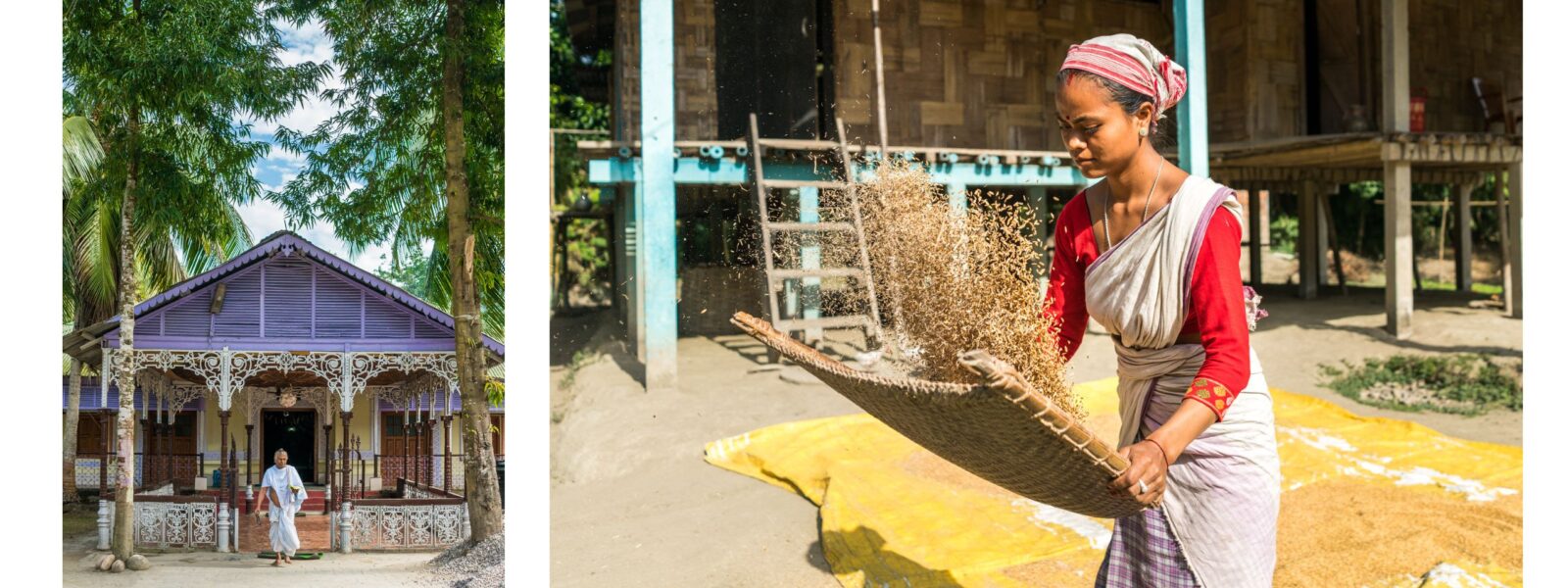
The Bengali crime canon has a rich heritage, reflecting the geneses of the region from colonialism to renaissance to the artistic capital of modern, independent India. This will be explored in Kolkata on the first days of this tour.
In Panchkori Dey’s detective novel Hatyakari Ke? (“Who is the murderer?”), a father arranges his daughter’s marriage to a characterless boy out of greed. Beyond the drama of this early Bengali whodunnit?, the social evil of arranged marriages, particularly the suffering of the girls involved, is a central theme. Dey’s book slips into the wider artistic movement of the Bengal Renaissance.
The Bengal Renaissance, was a social and artistic movement that took place in Bengal from the late 18th century to the early 20th century. The movement is commonly regarded as having concluded with two of its most famous names: Rabindranath Tagore, Asia’s first Nobel laureate, and Kazi Nazrul Islam. The movement questioned the existing customs and rituals in Indian society such as the caste system and sati – the practice in which a widow sacrifices herself by sitting atop her deceased husband’s funeral pyre. The Bengal Renaissance advocated for societal reform – the kind that adhered to secularist, humanist and modernist ideals.
After independence, with Bengal split in two, the post-Tagore literary scene was dominated by Premendra Mitra. An outstanding poet, Mitra was the creator of the poet-cum-detective Parashar Barma. Writing in the ‘50s, a time when the government was viewed with optimism in a young Indian republic, Parashar is generally employed by the government to uncover smuggling and espionage rings.
However, it was in the ’60s that Bengal’s most famous detective first emerged. Feluda, 27-year old amateur detective, was created by Satyajit Ray. Unlike Sherlock Holmes, who rarely travelled, Feluda is a globetrotter, solving crimes in Darjeeling, Sikkim and Hong Kong, accompanied by his young cousin Topshe. Written for children, Ray stressed the need for these stories to be kept clean and avoid “the backbone of crime-thrillers.” Meaning: “No illicit love, no crime passionnel, and only a modicum of violence.” In this way, Feluda is less Bengal’s Bond, and more its Tin Tin.
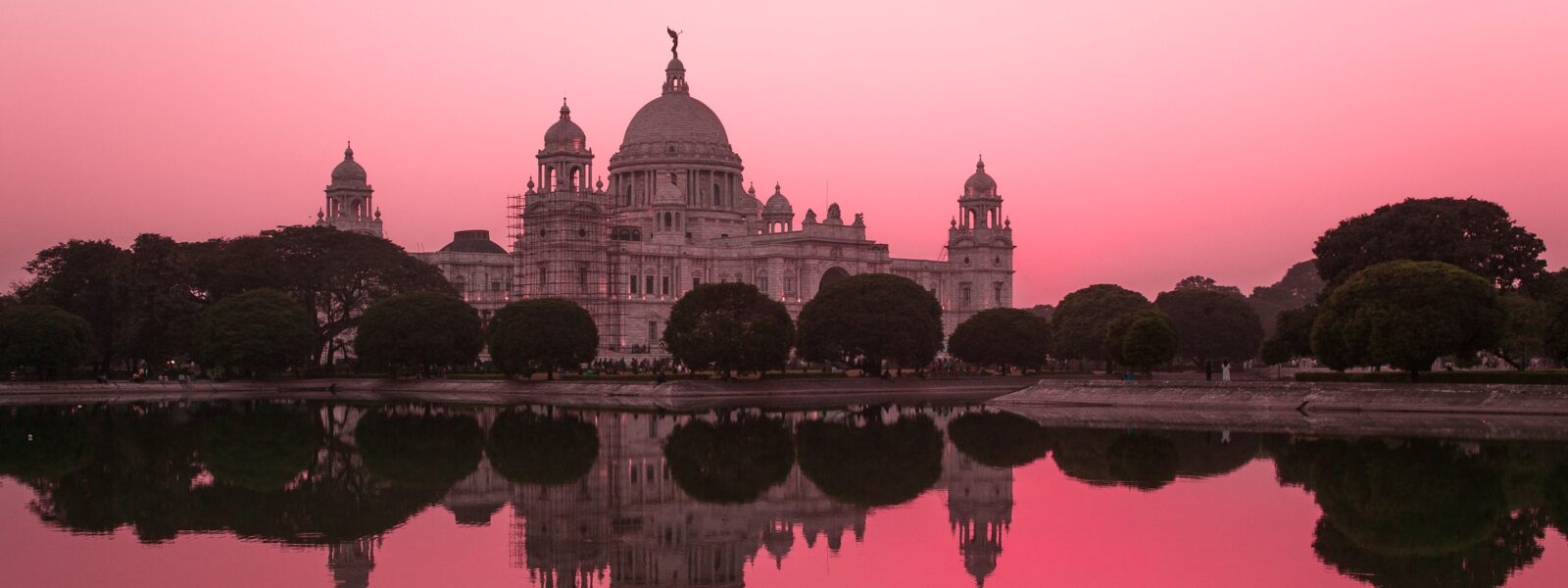
“Think, my friend,” said Poirot’s voice encouragingly. “Arrange your ideas. Be methodical. Be orderly. There is the secret of success.”
The closed circle mystery format is a hallmark of detective fiction. In this structure, the suspects – and often the detective – are confined to a limited environment, such as a remote country house, an isolated island or – indeed – a luxury cruise ship. This physical and social isolation ensures the culprit must be among the small group present, intensifying the suspense and narrowing the field of inquiry.
Popularized by authors like Agatha Christie, particularly in novels such as Death on the Nile and And Then There Were None, the format thrives on its ability to blend logic and misdirection. Each character is drawn with secrets, motives and alibis woven into a web that the detective must untangle.
On one evening on the boat, so to set the scene, there will be a film screening of Death on the Nile. Abir will introduce the film and present the heritage of the closed circle mystery.

When we ran this journey in February 2025, we had a selection of accomplished authors who signed-up to join us, offering to our group their own experiences as published writers. These writers included Laura Shepherd-Robinson, the award-winning, Sunday Times and USA Today bestselling author. Laura’s latest novel, ‘The Square of Sevens’, was a Sunday Times bestseller and a Book of the Year in the Sunday Times and the Guardian.
Olga Wojtas, author of the “Miss Blaine’s Prefect” series, said that Death on the Brahmaputra was “an absolutely outstanding trip, perfect from beginning to end. As a novelist, I chose it specifically because it was led by award-winning crime writer Abir Mukherjee, complete with masterclasses. But the entire trip was superbly organised with fascinating excursions and talks, and would be enjoyable for anyone.”
Harriet Tyce, author of four novels to date, including the Sunday Times bestsellers ‘Blood Orange’ and ‘The Lies You Told’, described it as “truly magical”. Sunday Times bestselling novelist Erin Young, author of ‘The Fields’ and ‘Original Sins’, said it was “one of those rare tours that manages to combine many different elements seamlessly & does all of them brilliantly.”
Erin says:
“For those wanting to write (or those simply curious, or those who love books) Abir’s masterclasses were a huge hit. In my experience there are very few writers who manage to combine a class with such depth of insight into writing and publishing, with such great humour!
“My other highlights included Calcutta – such a buzzing, frenetic, and fascinating city. The people were lovely, the food incredible, and the sites and history so interesting, especially when viewed alongside Abir, whose historical series of novel is set here. I feel we got to know sides of the city that few other visitors would, which was a real privilege.
“All in all, there was a great mix of adventure along with time to relax. I loved having a morning of exploration and travel, then coming back to the boat for cold towels, welcome drinks & a chance to lounge on the deck with a G&T and watch the sun go down over the wild riverscape.”
See more in our Visitors’ Book.
In the heart of Kolkata, this is an escape from the city … and a love-letter to it.
An immaculately restored 1920s townhouse. A love-letter to the city.
Tea bungalow in Assam. Wake up amongst the plantation with tea in dainty porcelain.